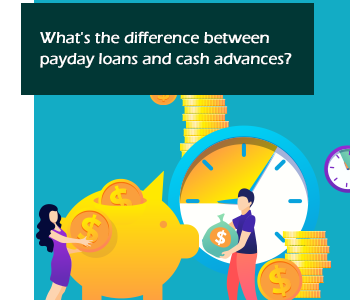What is the difference between Cash advances and Payday loans?

Payday loans and cash advances offer the option to borrow against your forthcoming paycheck. This helps address immediate financial requirements. But, due to high borrowing fees, these services may pose more risks than benefits. If you are in a financial bind, you might be curious about distinguishing between these two. Both avenues offer rapid access to funds. But, it’s essential to note several crucial distinctions. Payday loans vs cash advances: this blog will help you understand the differences better!
What is a payday loan?
A payday loan is a short-term, high-interest loan designed to be repaid in full on the borrower’s next payday. These loans are for small amounts. Borrowers often provide the lender with a post-dated check or allow an electronic withdrawal from their bank account for repayment. People know payday loans for their quick approval process and accessibility. They also know that payday loans come with interest rates, making them expensive. Consumer advocates and regulatory bodies often criticize payday loans. They have high costs and can trap borrowers in a cycle of debt.
What are cash advances?
Cash advances refer to short-term loans provided by financial institutions or alternative lenders. Payday loans must be repaid in full on the borrower’s next payday. In contrast, cash advances may have more flexible repayment terms. They allow borrowers to access a part of their upcoming paycheck or credit limit in advance, usually with a fee or interest charge applied. You can get cash advances through various channels. These include ATM withdrawals, credit card transactions, or app-based services. While they offer quick access to funds, and cash advances.
Payday Loans vs Cash Advances
There are 4 key differences between payday loans and cash advances. They are:
- Repayment Terms:
Payday Loans: Need full repayment on the borrower’s next payday, usually within two to four weeks.
Cash Advances: May have more flexible repayment terms, allowing borrowers to repay the advance over a longer period, often in installments or with the option to carry a balance.
- Accessibility:
Payday Loans: Generally obtained through storefront lenders or online platforms specializing in payday lending.
Cash Advances: Can be obtained through various channels, including ATM withdrawals, credit card transactions, or app-based services offered by banks or alternative lenders.
- Channels of Obtaining Funds:
Payday Loans: Borrowers usually receive funds in the form of a check, cash, or direct deposit into their bank account.
Cash Advances: Funds may be accessed through ATM withdrawals, cash withdrawals at a bank, credit card transactions, or app-based services that help cash advances.
- Fees and Interest Rates:
Payday Loans: Come with high fees and interest rates, often resulting in an APR (Annual Percentage Rate) of several hundred percent.
Cash Advances: Also carry high fees and interest rates, but the specific terms may vary depending on the lender, the method of obtaining the advance, and the borrower’s creditworthiness.
Both payday loans and cash advances provide quick access to funds. But, cash advances may offer more flexibility in repayment terms. They may also offer more channels for obtaining funds. Yet, borrowers should use both options since they tend to be expensive and can lead to a cycle of debt if not managed.
Get a cash advance or payday loan from a direct lender
Secure a payday loan or a cash advance by selecting EZPaydayCash, your reliable direct lender. Trust in us to provide you with a legitimate offer, free from any brokerage or dubious deals. Apply directly with us for a transparent solution to your short-term financial requirements.